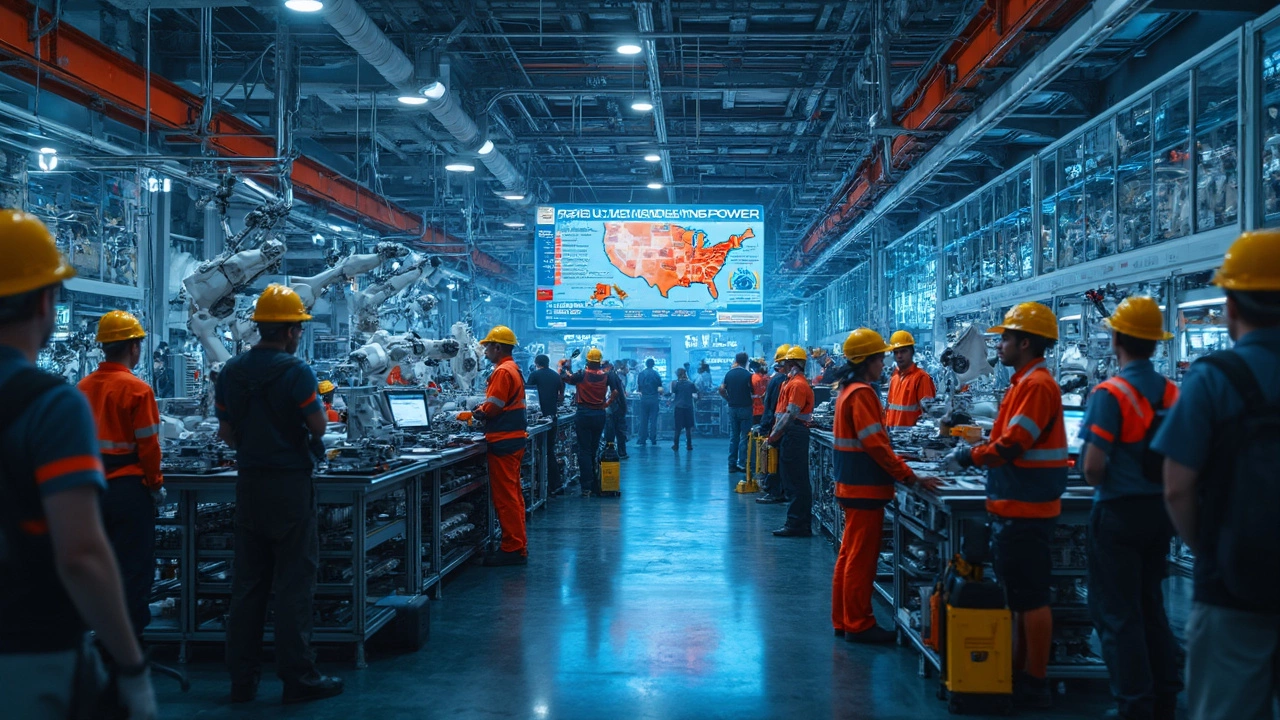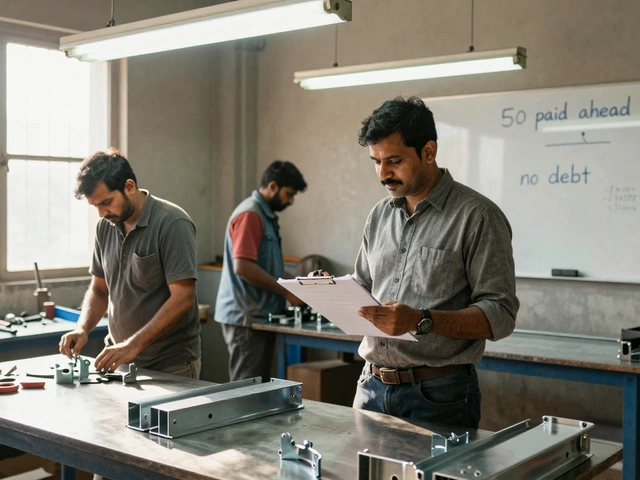Where the US Ranks in Global Manufacturing: Surprising Facts and Analysis

You wouldn’t know it from the headlines, but the US is an absolute giant when it comes to manufacturing. Still, if you were to sit next to my cat Molly as she sprawls across the laptop, you’d see I spend far too much time chasing stats that prove it. Numbers don’t always match the noise, though. So, where does the US actually stand in global manufacturing?
The US Manufacturing Rank: By The Numbers
If you hit up Google, you’ll find endless lists ranking countries by manufacturing muscle. The main event: China and the US. According to the United Nations Statistics Division’s latest numbers for 2024, China leads the planet in manufacturing output, pumping out roughly $4.9 trillion worth of stuff each year. The US is right on its heels, with manufacturing output clocking in at around $2.3 trillion.
Some people are shocked when they hear the US is still the world’s second-largest manufacturer. The story floating around is that America’s factories have vanished, replaced by ghosts and tumbleweed. In reality, the US makes more in value than ever before; it’s just that robots and newer factories do it with fewer workers, and a lot of boring assembly jobs moved offshore. But anything high-tech, medical, aerospace, chemical, or defense-related? US factories are absolute beasts in these fields. And when Wall Street or politicians talk about a US ‘manufacturing comeback,’ really, they mean making a dent in the decline of less sophisticated goods.
Here's a quick global snapshot of the top dogs in manufacturing for 2024, based on the value of goods produced (figures in trillions of USD):
| Country | Manufacturing Output (USD, trillions) | Main Manufacturing Sectors |
|---|---|---|
| China | 4.9 | Electronics, machinery, clothing, metals |
| United States | 2.3 | Aerospace, chemicals, pharmaceuticals, machinery |
| Japan | 1.0 | Automobiles, electronics, machinery |
| Germany | 0.8 | Automobiles, industrial machinery, chemicals |
| South Korea | 0.5 | Electronics, ships, vehicles |
For all the talk of decline, US manufacturing still makes up a fat slice of the global pie—about 15% of all manufactured goods by value. That puts the US in the number two spot, right behind China. The gap is bigger than it was a couple decades ago, but it’s not some tragic wipeout.
One thing that confuses people: measuring output in ‘value’ instead of ‘volume.’ America outsources a lot of low-cost production, but the high-value stuff—the jet engines, medical devices, satellites—still gets made at home. If you just counted how many ‘things’ come off the line, China crushes everyone. If you tally up the dollar value and complexity, the US is king in many advanced sectors.

Why US Manufacturing Still Matters (And Surprises People)
Molly the cat has no idea how important manufacturing is, but if she did, she’d probably sit on the stats. Good thing I’m here. People underestimate US manufacturing because it’s invisible to most regular folks. Factories aren’t in urban centers anymore, and much of the real action is behind corporate fences or in sterile labs. So, why care about rankings?
Manufacturing is the backbone of American innovation. Companies like Boeing, Tesla, and Pfizer are not just making physical goods, they’re leading research and development worldwide. The US pours more than $340 billion a year into R&D, mostly tied to making new products that upend the marketplace. That’s one of the reasons why, even with fewer workers, the US keeps its competitive edge. Even Foxconn, the famous Apple supplier, has invested in factories and research centers stateside.
Here’s a wild fact: The average US factory worker produces more than four times as much value per hour now as they did in 1987, mostly thanks to crazy technology leaps. Americans make way more stuff with way less sweat. Robotics, automation, AI-driven systems—these are giving US manufacturers an edge in precision and consistency. Forget old images of dirty, noisy plants filled with hundreds of people. A lot of modern US factories look like spaceships, with robotic arms and only a handful of high-skilled people monitoring screens.
Besides, US manufacturing isn’t just about building things. It supports over 12 million jobs directly and another 17 million indirectly, thanks to supplier industries and the domino effect across the economy. According to 2025 data from the National Association of Manufacturers, manufacturing alone adds nearly $2.8 trillion to US GDP, a whopping number nobody should ignore.
But US manufacturing is also surprisingly green by global standards. Products made in the US, on average, are produced with lower emissions than in most developing countries. Tight government rules and pressure from customers have forced US industries to cleaner, more energy-efficient tech. Not perfect, but moving in a better direction after decades of criticism.
And those headlines about reshoring? There’s truth in them. Big names like Intel and TSMC are spending tens of billions to build advanced chip factories in Arizona and Ohio. As the global chip shortage showed, having local supply chains matters for everything from cars to phones to medical gear.

How US Manufacturing Holds Up Against Global Competition
So, what’s holding America back from retaking the world’s top manufacturing spot? It’s not brains or machines—it’s the sheer cost. American workers are paid much more, and factories face strict rules. China’s edge is low labor costs, government subsidies, and huge economies of scale. That means for now, high-volume, low-margin goods like toys, clothes, and simple electronics usually come from Asia. But when things get complicated, expensive, or sensitive? The US is often the first pick for manufacturing contracts.
The US also punches above its weight in sectors that demand precision and reliability, like aerospace (think Boeing and Lockheed Martin), high-performance vehicles, and pharmaceuticals. American companies export around $1.7 trillion worth of manufactured goods every year. About half of those exports go to Canada and Mexico, neighbors thanks to trade deals like the USMCA. The rest? Traded everywhere from Europe to Southeast Asia.
Another overlooked fact: US manufacturing plants are extremely diverse. In the Midwest, there’s Detroit and Chicago churning out cars and heavy machinery. The South is booming with new auto factories, battery plants, and electronics. California and Texas? Leaders in high-tech gadgets, chips, and energy gear. People picture rusty ruins or empty mills, but the new generation of manufacturing jobs looks nothing like the old days. These jobs demand skills—think software, advanced welding, robotics, logistics—not just muscle.
There’s also the stuff most folks never see but use every day, like chemicals for food processing, specialty plastics, and medical implants. US companies dominate many of these ‘hidden’ markets. Even pet food—believe it or not, most kibble and treats for cats like Molly are still produced in US factories, so she has America’s industrial muscle to thank next time she crunches a snack.
If you dig into the future, the buzz is about ‘Industry 4.0’—basically, using the Internet of Things (IoT), AI, robots, and cloud computing to link every part of a supply chain to squeeze out every last inefficiency. America’s tech sector and its factories are blending together faster than ever. That’s huge for making smarter, more resilient production lines, especially with global shocks like COVID-19 or international tensions. In 2025, a company that leaves all manufacturing in one place is asking for trouble. American manufacturers know this and invest billions to hedge their bets.
US government policy seems to finally notice all this. There’s fresh energy to strengthen ‘Buy American’ rules, tax credits for clean factories, and funding for workforce training. Plus, billions are pouring into high-priority sectors like semiconductors, batteries, EVs, and medical tech. The Inflation Reduction Act and CHIPS Act alone promise to shift the playing field long-term.
Sure, there are big challenges. Skilled worker shortages are real—retirements and changing tech leave huge gaps that schools haven’t filled fast enough. Costs are high, and regulations slower to change than engineers wish. Trade wars, tariffs, and unpredictable global politics make things messier. But when the chips are down, the US still brings size, speed, and a knack for reinvention.
In the global game of manufacturing, the US stands tall in second place—not just as an echo of the past, but still a hard-hitting contender shaping the future. And what the country lacks in low-cost production, it more than makes up for in brains, creativity, and track record under pressure. Molly doesn’t care about chip fabs, but when she’s napping next to my phone or lying on an American-made medical device box, she’s a silent part of this massive machine.





